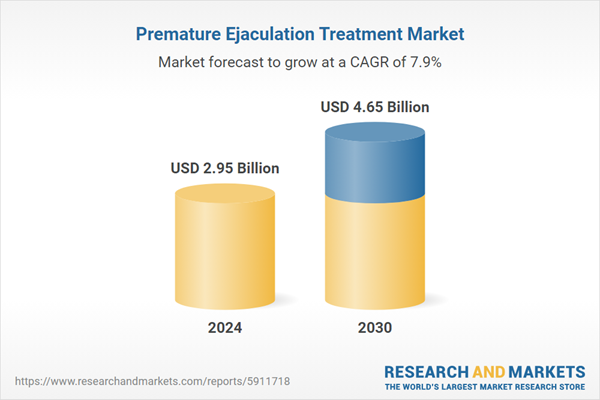Speak directly to the analyst to clarify any post sales queries you may have.
10% Free customizationThis report comes with 10% free customization, enabling you to add data that meets your specific business needs.
As attitudes toward sexual health evolve, more individuals are seeking professional help for conditions like PE. This shift has expanded treatment options, including pharmaceuticals and behavioral therapies. Healthcare providers are introducing new, more effective treatments, including non-invasive therapies and oral medications, such as selective serotonin reuptake inhibitors (SSRIs) and local anesthetic creams. As awareness of available treatments increases, the market continues to experience consistent growth, driven by a demand for tailored solutions.
Key Market Drivers
Rising Pharmaceutical Innovation
Pharmaceutical companies are investing heavily in research and development to create medications specifically targeting premature ejaculation. For instance, dapoxetine, a selective serotonin reuptake inhibitor (SSRI), has been approved in multiple countries for PE treatment, offering targeted and effective options. These specialized medications have enhanced the efficacy of PE treatments, improving control over ejaculation timing and patient satisfaction. Ongoing developments in new medications aim to deliver better outcomes while reducing side effects, thereby improving patient compliance and comfort. Reducing side effects further enhances the appeal of treatments, as patients prefer therapies with minimal disruption to their daily lives.Key Market Challenges
Side Effects and Safety Concerns
Certain pharmaceutical treatments for premature ejaculation, including SSRIs like dapoxetine, can cause side effects such as nausea, dizziness, headaches, and sexual side effects like reduced libido or erectile dysfunction. These side effects can reduce patient compliance and overall satisfaction. As medication responses vary from person to person, finding the most effective treatment can often involve a trial-and-error process, which can be frustrating for both patients and healthcare providers.Additionally, some individuals may have underlying health conditions or take medications that may interfere with PE treatments. Drug interactions are a concern, requiring healthcare providers to carefully assess potential risks. The long-term safety of certain treatments is not always well-established, and concerns about prolonged use may discourage some individuals from seeking or continuing treatment. Topical anesthetics, such as lidocaine creams, may also reduce sensation, affecting sexual pleasure for both partners.
Key Market Trends
Patient-Centric Approach
Healthcare providers are increasingly adopting patient-centric strategies by creating personalized treatment plans for individuals with PE. These plans take into account the severity of PE, underlying causes, medical history, and patient preferences. Patients are encouraged to actively participate in the decision-making process regarding their treatment options, leading to more collaborative and informed choices. The patient-centric approach emphasizes patient education and counseling, helping patients understand the condition, treatment options, potential side effects, and expected outcomes. Treatments may also include a holistic approach that addresses the physical, psychological, and emotional aspects of PE. Telemedicine and remote monitoring technologies are making it easier for patients to access care from home, enhancing convenience and accessibility while maintaining a patient-focused approach.Key Market Players
- Absorption Pharmaceuticals Inc.
- Allergan PLC
- AstraZeneca PLC
- Bayer AG
- Eli Lilly and Company
- GlaxoSmithKline PLC
- Innovus Pharmaceuticals Inc.
- Merck & Co., Inc.
- Pfizer, Inc.
- Teva Pharmaceutical Industries Ltd.
Report Scope:
The Global Premature Ejaculation Treatment Market has been segmented as follows:
By Drug Type:
- Dapoxetine
- Phosphodiesterase Type 5 (PDE5) Inhibitors
- Selective Serotonin Reuptake Inhibitors
- Topical Anesthetics
- Zertane
By Treatment Type:
- Oral Therapies
- Topical Therapies
By Dosage Form:
- Pills
- Spray
By Distribution Channel:
- Hospitals
- Online Pharmacies
- Retail Pharmacies
By Region:
North America:
United States, Canada, MexicoEurope:
France, United Kingdom, Italy, Germany, SpainAsia-Pacific:
China, India, Japan, Australia, South KoreaSouth America:
Brazil, Argentina, ColombiaMiddle East & Africa:
South Africa, Saudi Arabia, UAECompetitive Landscape
This section includes detailed company profiles of the major players in the Global Premature Ejaculation Treatment Market.Available Customizations:
TechSci Research offers customization of the report to meet specific business needs, including the addition of up to five extra company profiles for further insights into the competitive landscape.This product will be delivered within 1-3 business days.
Table of Contents
Companies Mentioned
- Absorption Pharmaceuticals Inc.
- Allergan PLC
- AstraZeneca PLC
- Bayer AG
- Eli Lilly and Company
- GlaxoSmithKline PLC
- Innovus Pharmaceuticals Inc.
- Merck & Co., Inc.
- Pfizer, Inc.
- Teva Pharmaceutical Industries Ltd.
Table Information
| Report Attribute | Details |
|---|---|
| No. of Pages | 181 |
| Published | February 2025 |
| Forecast Period | 2024 - 2030 |
| Estimated Market Value ( USD | $ 2.95 Billion |
| Forecasted Market Value ( USD | $ 4.65 Billion |
| Compound Annual Growth Rate | 7.8% |
| Regions Covered | Global |
| No. of Companies Mentioned | 10 |









